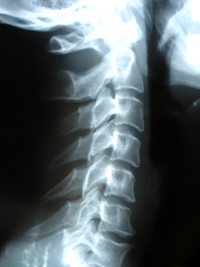Before we can diagnose your neck pain and recommend treatment, let’s first talk a little about the anatomy of your neck.
Anatomy of the Neck Or Cervical Spine:
The neck has seven bones and for that matter, most mammals have seven bones in the neck. Ligaments hold these seven bones together and are made of very dense and tough collagen tissue with very little blood supply.
Causes of Neck Pain:
Neck pain can arise from poor posture over time or perhaps sleeping in an awkward position. Neck pain can also occur as a result of direct trauma such as a whiplash injury from a car accident that will cause a stretching and tearing of the ligaments and muscles. Sports injuries to the head, neck and shoulder regions can also induce pain. Even the birthing process, where one is delivered with forceps and the head and neck are pulled from the birth canal, can cause neck pain later in life.
Most of these mechanisms of injury will stretch ligaments in the neck resulting in a sprain. When muscles are stretched beyond their limits, this is called a strain. Besides irritated muscles and ligaments causing pain, there are other possibilities.
Other more serious causes would include:
- herniated disc
- disc bulge
- disc protrusion
- degenerative disc disease
- stenosis

Neck Pain Symptoms:
- stiffness at the base of the skull that increases with movement
- sharp stabbing pains into the shoulder
- loss of motion when turning head up and down, left and right
- tension headaches
- loss of sensation in the arms and hands due to pinched nerves in neck
- loss of grip strength
- nausea and vomiting
- moodiness and irritability
- muscle spasms
- difficulty swallowing or eating
Neck Pain Diagnosis:
Chiropractors diagnose a neck sprain by performing a comprehensive physical examination. During the physical examination, the chiropractor will ask you how the injury occurred, measure the range of motion of your neck, check the muscle strength in your neck,and check for any point tenderness.
They will also order radiographs (X-rays) so they can look closely at the bones in your neck. The main thing they are looking for are changes in the position of the vertebra, often known as subluxations. This evaluation will help the chiropractor rule out or identify other sources of neck pain, such as spinal fractures, dislocations, arthritis, herniated discs, and other serious conditions.
Neck Pain Treatment:
All sprains or strains, no matter where they are located in the body, are treated in a similar manner. Chiropractic adjustments are very critical to restore the proper position of the vertebrae so as the neck heals, it can do so in the proper alignment. The worst thing one can do is ignore these changes and think “the pain will go away”. While the pain may go away, if the spine is not properly realigned, the risk of developing arthritis and other neurological problems increases.
Pain relievers such as aspirin or ibuprofen can temporary relieve your pain, but they will not restore your proper spinal position.. Muscle relaxants are typically over-prescribed. Think about it; muscles spasm for a reason and that is to help contract around an injured spine and form a “muscular cast”.
This is done automatically as a defense mechanism to prevent further and more serious injury to your spine. If you take too many muscle relaxers, you are actually “disarming” your body’s own natural defense mechanism. This leaves you vulnerable to more serious injury as a result.
Ice packs applied for 15 to 30 minutes at a time, several times a day for the first 2 or 3 days after the injury if typically recommended. This will help reduce inflammation and discomfort. Although heat, particularly moist heat, can help loosen cramped muscles, it should not be applied too quickly.
Other treatment options include along with chiropractic adjustments:
- Massaging the tender area
- Ultrasound
- Cervical (neck) traction
- Aerobic and isometric exercise
Most symptoms of neck sprain will go away in 4 to 6 weeks. However, severe injuries, may take up to 6 months to a year to heal.
If you have recently suffered from a cervical sprain, or whiplash, don’t settle in on medications. Remember, misaligned vertebrae are “structural problems” while medications are a “chemical solution”.
What this means is that you don’t’ want to treat a structural problem with a chemical solution. This is where chiropractic treatment is so valuable – offering a structural solution to a structural problem.
If you have neck pain symptoms and are looking for treatment or a better diagnosis, call us at (614) 428-9310 and start feeling better today!